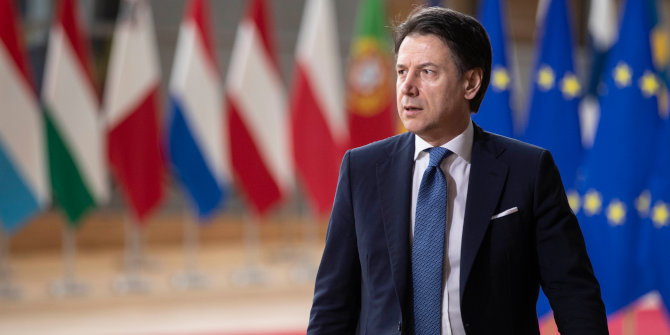 Italy has been one of the hardest hit countries in the world during the Covid-19 outbreak and there are significant concerns about the impact the pandemic will have on the Italian economy. Roberto Orsi writes that the Eurozone is rapidly heading toward a point where it will either have to adopt radical new measures to accommodate countries like Italy or risk seeing the currency bloc break apart.
Italy has been one of the hardest hit countries in the world during the Covid-19 outbreak and there are significant concerns about the impact the pandemic will have on the Italian economy. Roberto Orsi writes that the Eurozone is rapidly heading toward a point where it will either have to adopt radical new measures to accommodate countries like Italy or risk seeing the currency bloc break apart.
The Covid-19 pandemic is accelerating Italy’s slide towards its economic and financial endgame. While before the pandemic the country already found itself in a precarious balance between high debt and no growth, this shock is precipitating the situation by bursting the various arrangements and tactics that both Rome and Brussels/Frankfurt were employing to create a screen of credibility and creditworthiness. The discussion about the future of the Eurozone (whether there is one, for whom, and how) is back again.
A new economic environment
The pandemic is still in its growing stage as this piece is being written, yet it is already clear that it is going to be a crisis of historical dimensions. It will not be over by the end of April or May 2020. This means the world economy will be virtually brought to a standstill for a whole quarter. Afterwards, even if a recovery will surely take place, and barring a second wave of contagion later on, any return to normality will be complicated and relatively slow-paced.
It is difficult to estimate the death toll of such a pandemic and the scale of human suffering deriving directly or indirectly from the disease, and even more so the economic and social costs, but, judging by the unprecedented steps taken in all developed countries to prop up the economy, the economic and financial burden will be colossal.
States will have to borrow enormous sums in order to avoid financial collapse, thus expanding national debt by a large margin. In the 2008-2009 crisis, national debts ballooned by 30% to 50% of GDP or more, depending on the country, in a few years. It appears that this crisis will require a much larger effort. How much larger, nobody knows yet, as it will depend on the duration of the pandemic. Still, it can be expected that major economies will shrink by 8-10% in 2020, with Goldman Sachs forecasting -9% in Q1 and -34% in Q2 for the United States.
National debt expansion as the way forward?
Former ECB Governor Mario Draghi has argued in a recent piece in the Financial Times that high sovereign debt/GDP ratios will become the norm, at least for a while. He is certainly correct about this, but the quality of the debt and the underlying national economies are not the same for all, and markets know it.
The stakes are very clear: there are some countries, most notably Italy, which cannot expand their euro-denominated debt by 30% or 40% of their rapidly shrinking GDP, without explicit or implicit EU guarantees for the creditors. Without such a European guarantee, markets will not allow interest rates on Italy’s debt to remain extremely low, a requirement to keep interest payments at an acceptable level.
Alternatively, the creditors will mostly become the ECB system or the Italian banks, or both, (this has already been happening for a number of years). Italy, a country which has not even recovered its pre-2008 GDP, can hardly be expected to repay any more national debt under the same system of Eurozone rules which have been in place up to now, even with the significant formal and informal amendments and innovative practices of the Draghi era.

Italy’s Prime Minister, Giuseppe Conte, at a European Council meeting in February 2020, Credit: European Union
Currently, the approach to the crisis is the following: EU limits to budget deficits are lifted, at least for 2020, and the national governments can spend as much as necessary, issuing new national debt; the ECB will provide the liquidity to buy this through the banks, or directly; the ECB will keep interest rates as low as possible to minimise interest payments; later on, in the next few years, the debt burden will have to be reduced by growing the economy and/or repaying the debt, and budget deficit restrictions will be reinstated.
However, with the massive debt issuing that is now looming, who will support Italy when the debt/GDP ratio climbs from 135% in 2019 to 170%? To 180%? Those are the levels which triggered the debt crisis in Greece after 2010. Who believes that Italy will grow at an accelerated pace in the next decade? On the basis of what considerations? It appears therefore that the above-described public finance approach to this crisis will not work for Italy. The country’s leadership knows it, and they are looking for a different path.
Solidarity and the Eurozone’s architecture
The most straightforward way to stabilise Italy’s financial future revolves around the thorny question of the Eurozone’s mutual solidarity, its conditions and its limits. To understand this, one needs to go back to the question of the Eurozone’s fundamental architecture and ethos. If the national debts were pooled or shared in some way, or monetised by the ECB, part of Italy’s debt would be paid, in the long run, also by other euro members’ taxpayers, and such a European formal guarantee would reassure the markets, provided that Europe as a whole remains a credible debtor.
Debt pooling, whatever the financial arrangement, would require the overhaul of the Eurozone as it was initially conceived, to make it, by necessity, something that many within Europe, both governments and citizens, do not want. The Eurozone was supposed to be an exclusive club of high-performance economies, run with strict rules mirroring the best practices of the Bundesbank, and the fiscal restraint of northern European economies. The euro was supposed to make every economy more efficient internally and more competitive externally, by inducing structural changes to be managed by national governments under the supervision of EU authorities, with the goal of an increasing convergence in governance standards and results. Still, the underlying political agreement in the Maastricht Treaty called for a separation of national budgets, and the ultimate national responsibility for sovereign debt.
Instead, the results after two decades, whether or not caused by the euro, appear to be: 1) a persistent, even increasing divergence in the public finance performance in the North and in the South of the continent; 2) a perceived stagnation and/or worsening of living standards in numerous parts of the continent; 3) increased political pressure on the EU and the Eurozone project calling for radical reforms, going either towards debt pooling (sometimes unconditional), or towards the dismantling of the Eurozone/exit of single countries.
Whichever way one may look at it, it appears that the original project and architecture of the Eurozone is no longer tenable, if all members are to remain within it. The Eurozone as a single currency bloc may perhaps be able to survive in some form, but in order to do so, it must, at least temporarily (but still, for a long time, possibly decades): a) embrace the idea that it has failed to be the above-mentioned exclusive club of well-functioning economies; b) consider the Stability and Growth Pact as overhauled and no longer applicable; c) agree on a new identity and mission; d) agree on a new legal and political structure, one which goes beyond the concept of separation of national budgets.
The last point is the most difficult one. In principle, debt pooling could be agreed if there were a shared vision of what to do in the future in terms of macroeconomic and fiscal policies, and if there were enough chance of success. Such chances are not visible to most people. Besides, there is no clear political vision for further integration of EU or Eurozone members, as it is rather unavoidable, out of political and organisational considerations, that debt pooling would require a harmonised fiscal policy, and hence some sort of political union.
There could be partial forms of pooling, for instance for bonds related to particular kinds of investments (but who controls how the money will be spent? how can rules be enforced?), or bonds issued by a group of Eurozone members, but not all, for instance a “southern alliance” with France at the helm. On the other hand, numerous political leaders in the North have already expressed rather clearly the view that they wish to keep the ultimate separation of national budgets as a non-negotiable element of the Eurozone.
North vs. South?
Many in Italy regard resistance against debt pooling as a want of European solidarity, and a failure to live up to the political and ethical commitment from other EU members. However, should EU solidarity be unconditional? While it is certainly good to show solidarity at a time of acute distress (as is happening now), infinite and unconditional solidarity is ethically wrong. Once the emergency is over, it is not unfair to ask every country to return to a path of economic and financial sustainability. Is financial sustainability not the norm of every state budget, or even every household?
The possible existence of areas of the Eurozone permanently depending on transfers from other regions would be unfair and it would certainly generate, as is already happening, fierce political resistance. Solidarity should always be conditional in the long run. Italy is right in demanding solidarity (it will get it for as long as the pandemic continues), but there are many in Italy who are wrong in refusing to discuss and negotiate conditions, insisting on an incorrect solidarity concept.
If Italy’s position in demanding unconditioned solidarity is incorrect, the probable conditions to be put forth by many in the northern part of the Eurozone in case of national debt restructuring or another form of financial support for distressed countries, have problems of their own. Most notably, the structural adjustments which would be likely included in the conditions of any ESM activation, such as tax hikes and spending cuts, as already observed during the Greek crisis, will cause social and economic pain as a result of a longer and deeper recession, and produce political side-effects, such as the further spread of Euroscepticism, which are seldom taken into account, thus in the end worsening the EU’s political crisis.
Moreover, it is questionable whether such structural reforms would actually deliver meaningful, long-lasting results, and allow a country like Italy to return to a path of economic growth and financial sustainability. Spain and Portugal have certainly managed to recover from the 2008-2009 crash while implementing reforms which came as conditions to access EU support, but they did so by massively expanding their national debt and running high deficits for most of the past decade (Spain from 39.5% of GDP in 2008 to 95.5% in 2019; Portugal from 71.7% in 2008 to 117.7% in 2019), while Italy, as its debt already stood at 99.8% of GDP in 2008, was unable to do the same. Moreover, structural reforms are not addressing one of the most important economic issues in Italy, namely the now practically inevitable demographic collapse, which, according to a study by the Bank of Italy, will be a formidable headwind for the country from now onwards, leading to a scenario of permanent recession.
Both main positions now shaping the intra-EU debate, the one demanding unconditional solidarity and the abandonment of most metrics of economic performance, as well as the one pretending to have the right (technical) solutions for Italy’s and the Eurozone’s problems, are wrong. If some kind of solution can emerge from the current predicament, it should be one starting from the acknowledgment that the dominant way to conceptualise the Eurozone’s governance has historically failed.
It has failed because it was grounded on the illusion that law (in the form of international treaties initially envisaged in the late 1980s, and thus in a completely different economic, social, and demographic landscape) can predict and regulate any occurrence in political and economic life, indefinitely. It has failed because of excessive juridification as the most obvious degeneration of post-war Ordnungspolitik.
If such a failure were to be acknowledged, however, the conclusion may arise that the only convenient path forward is an orderly démontage of the currency bloc. This option is surely under consideration by some, particularly in the North, even if it implies huge political costs and great uncertainties. Exceptional times favour exceptional decisions. The Covid-19 pandemic offers a unique opportunity for radical moves. If the Eurozone project is to be abandoned, now is the time.
Please read our comments policy before commenting.
Note: This article gives the views of the author, not the position of EUROPP – European Politics and Policy or the London School of Economics.
_________________________________
 Roberto Orsi – University of Tokyo
Roberto Orsi – University of Tokyo
Roberto Orsi is an Associate Professor in the Graduate School of Public Policy at the University of Tokyo.





I agree on all of this document but the end.
How can you say that the EU must change the basic foundations of its uinion and do not show us your idea about the desing of the next union ?
If you think that the structure of this union is wrong, evidently you have an idea of how it should be.
I think that this must be part of your paper.
I hear from many quarters that this union is wrong and it should be overhauled. I agree.
But I have also produced a paper where I explain how the next union should be done.
I proposed, years ago, what I think is the Alternative for Europe, but I did not meet much success.
Now most actors of this drama are crying and fighting each other, but not much serious thinking is done on this New Europe.
I wish people of academia would want to fill this gap
Absolutley correct. But, not humanly possible because who are in charge. Euro will die and a new one will born. It’s the way it will be.